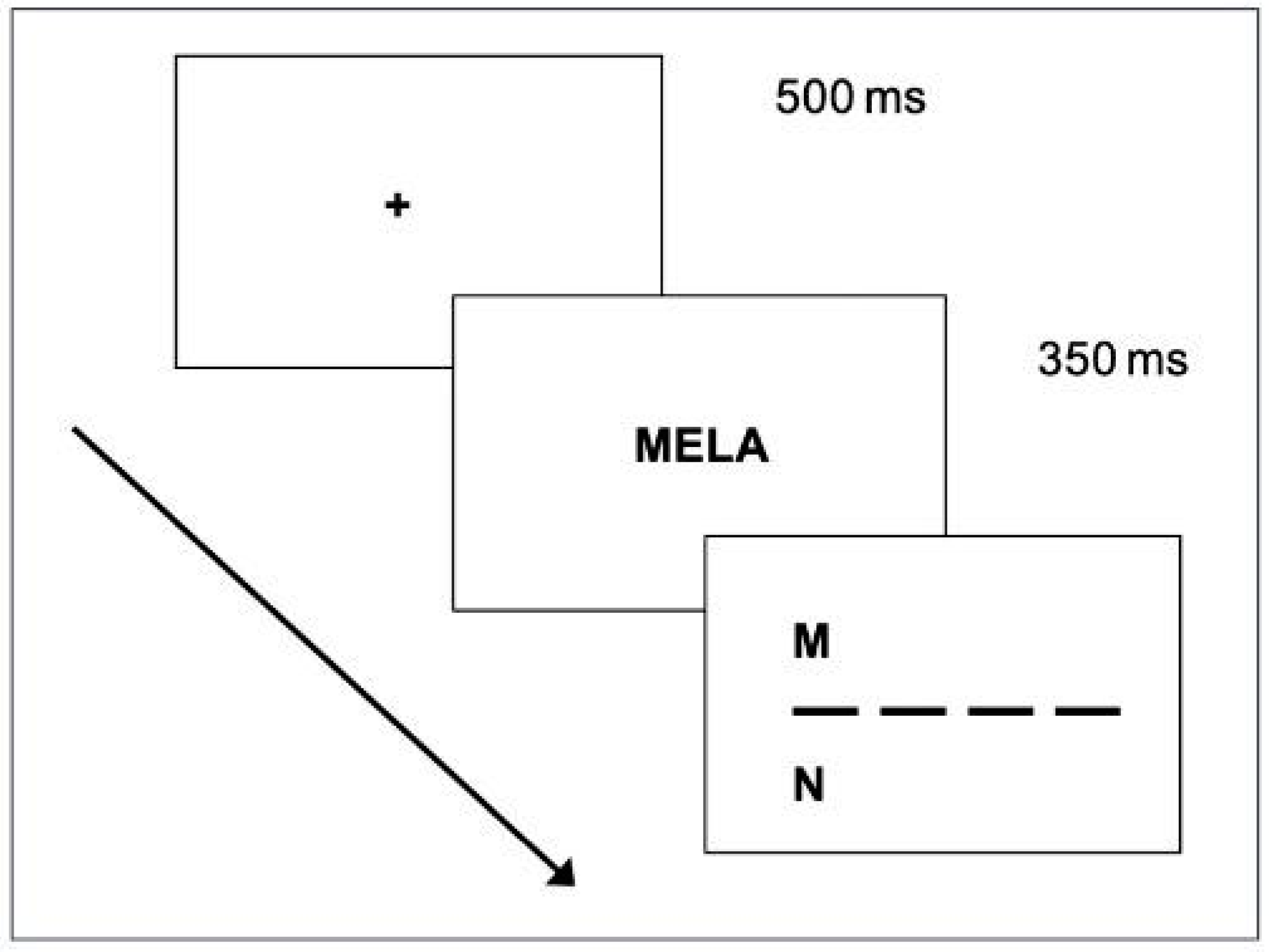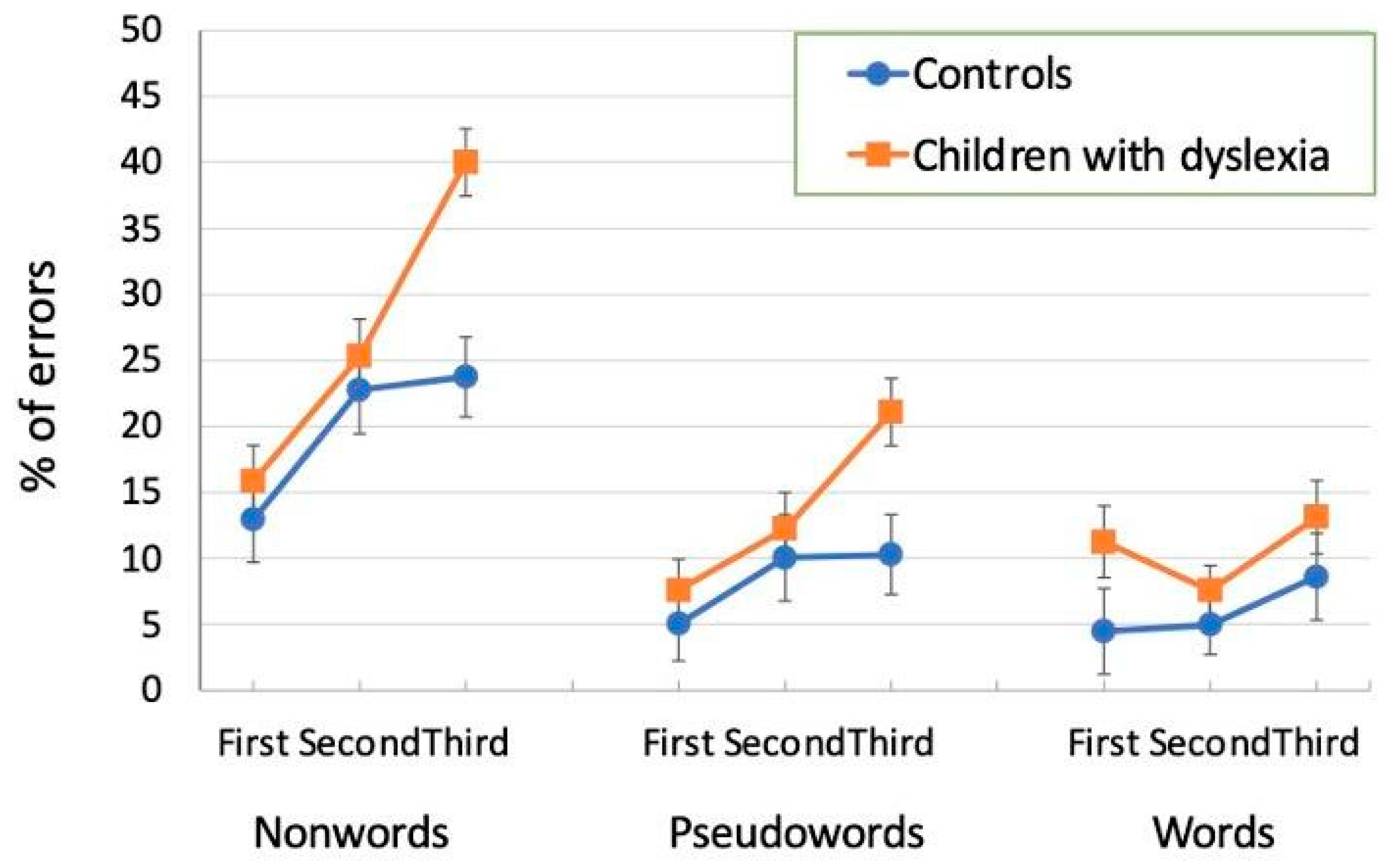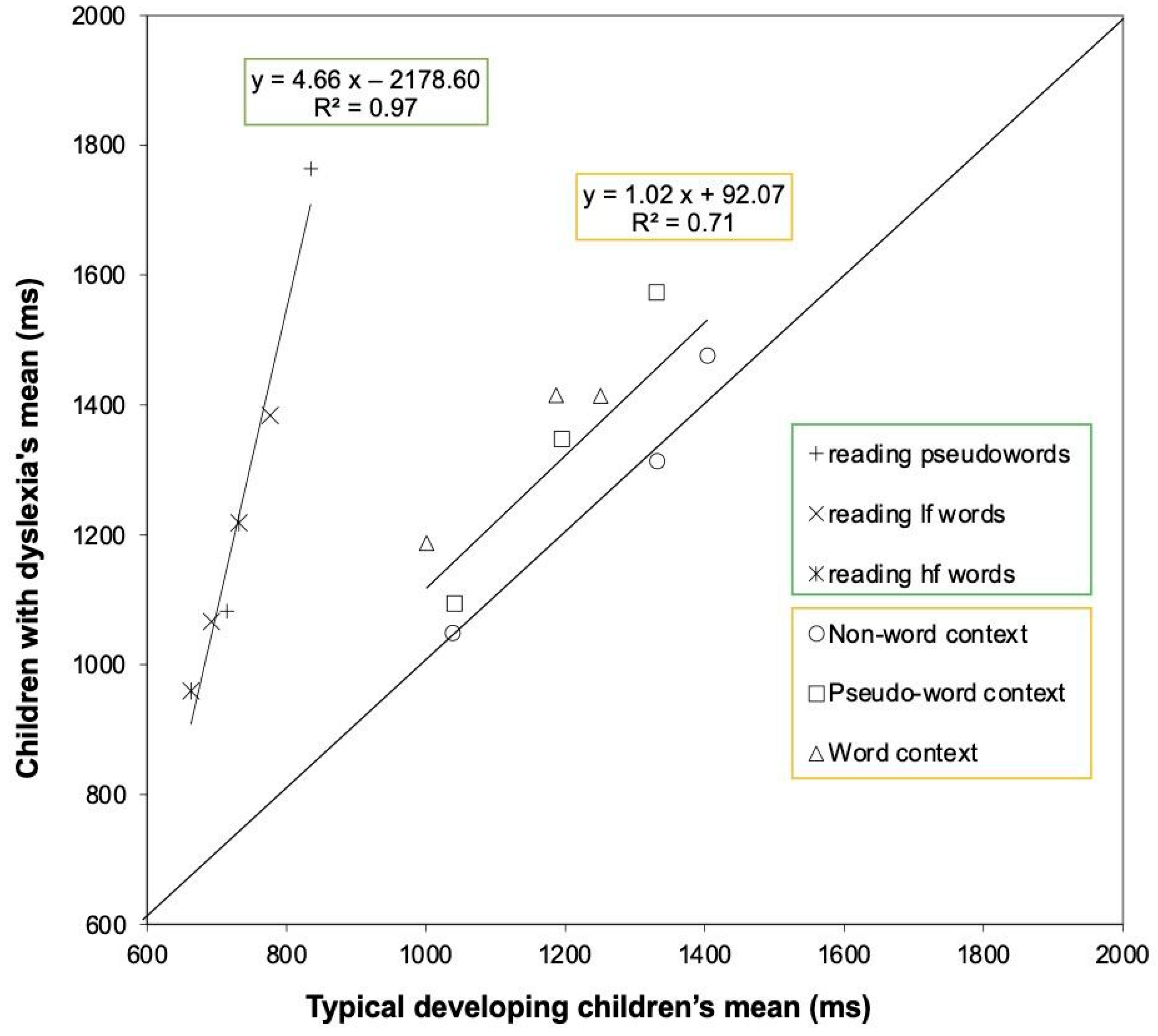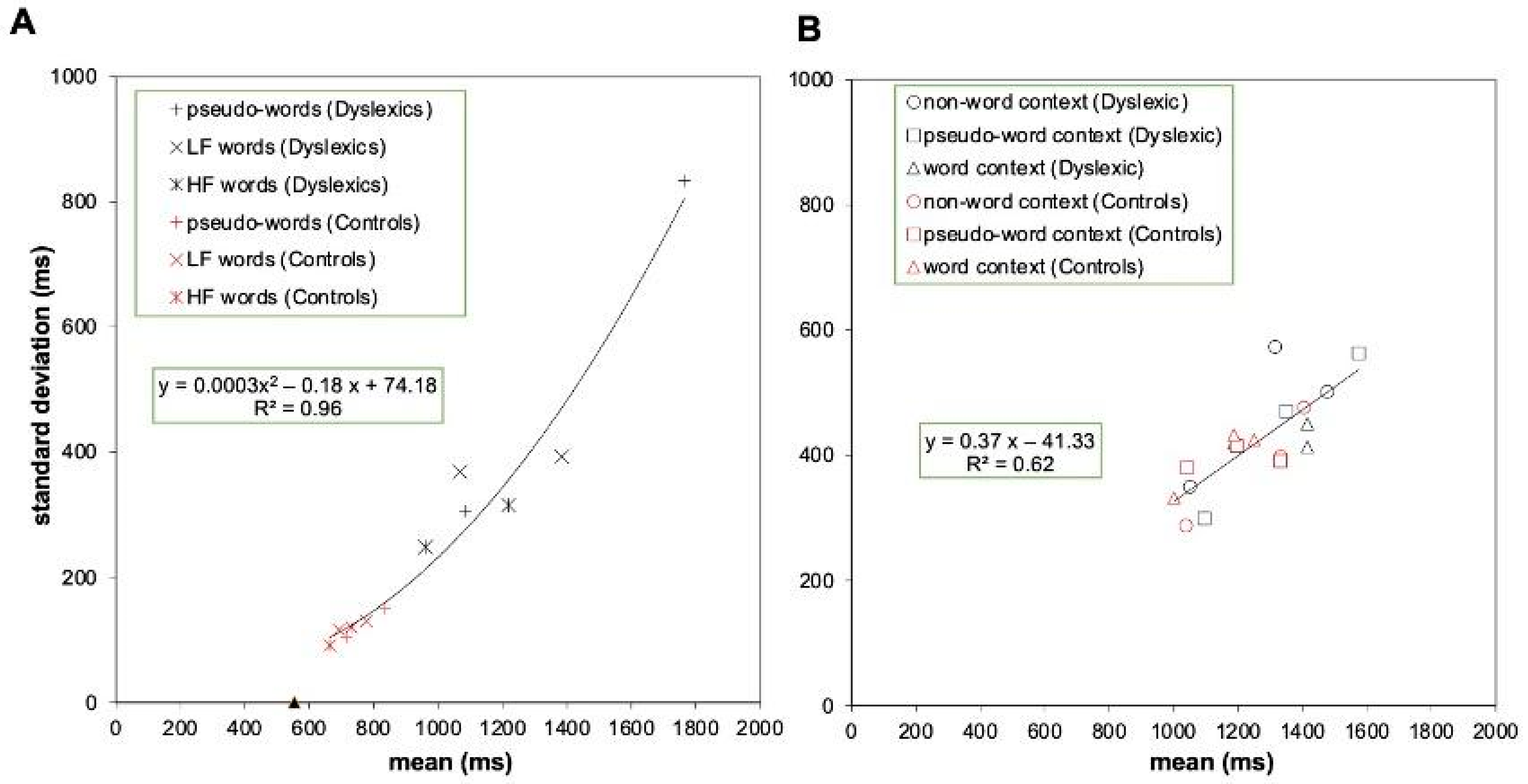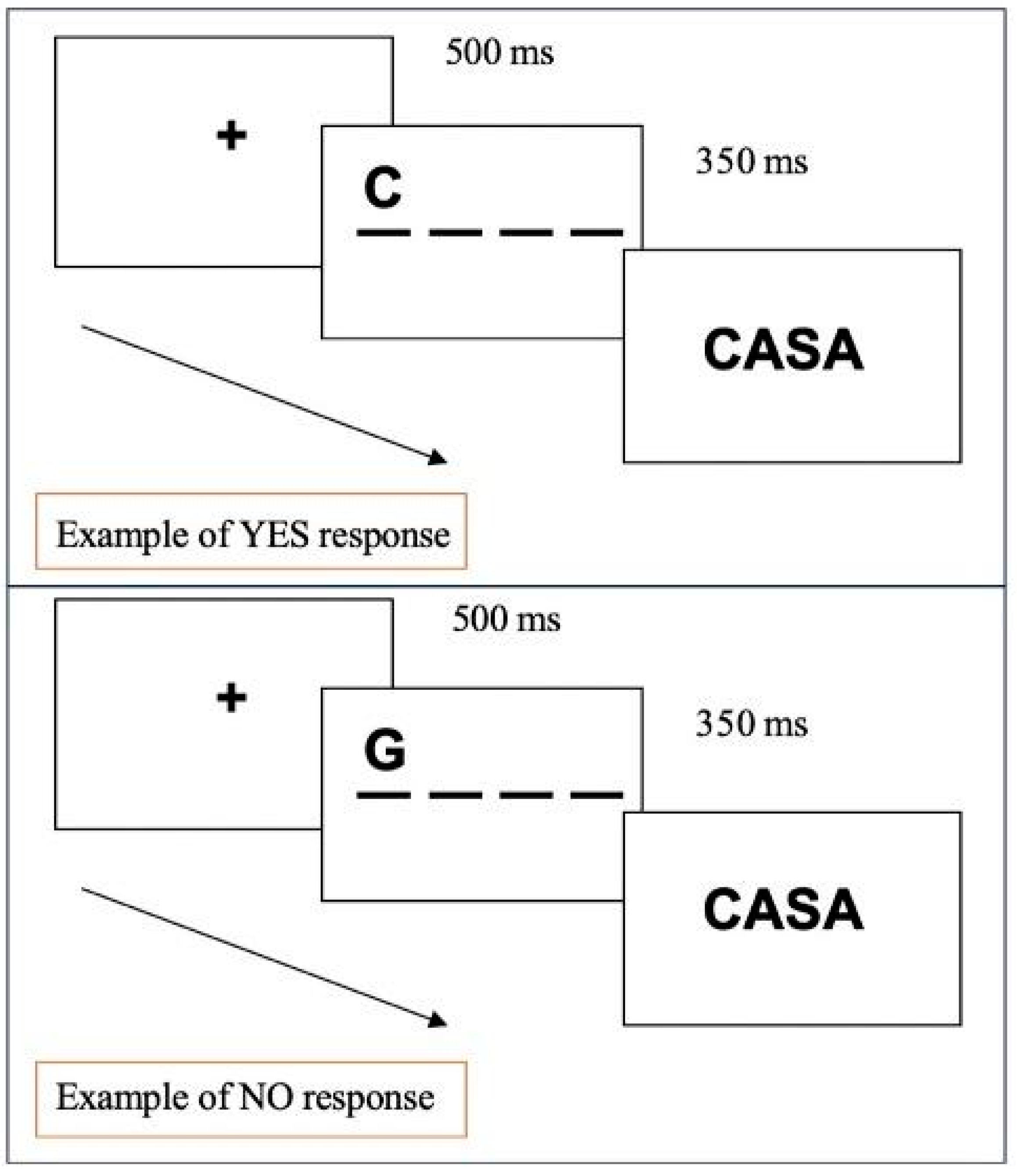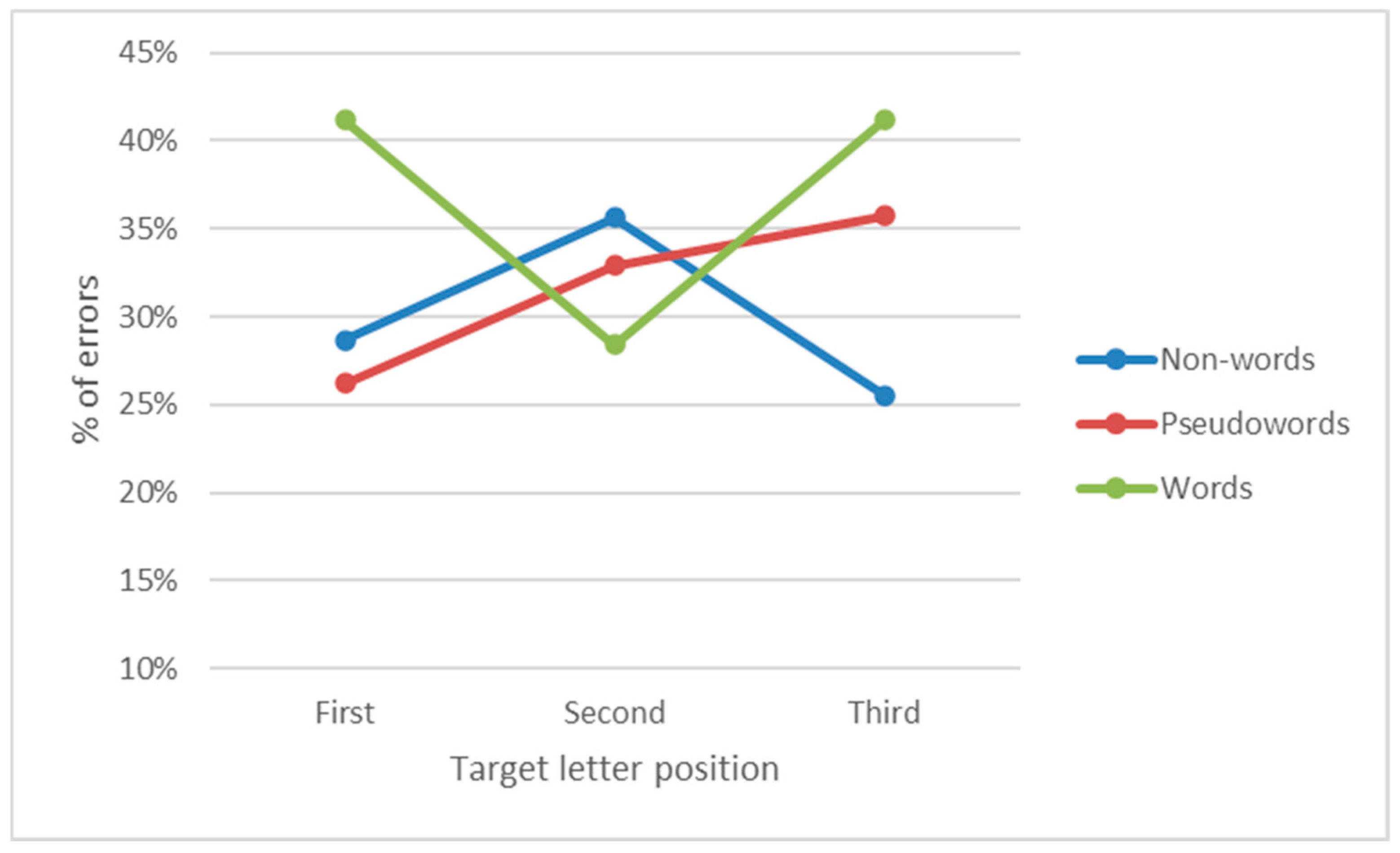1. Introduction
In orthographies with consistent grapheme-to-phoneme correspondences, such as Italian (the orthography object of the present study), children with dyslexia read slowly, although in a relatively accurate way [
1,
2,
3,
4]. Eye movement recordings while reading texts or lists of words reveal very small and numerous saccades indicative of their inability to process words holistically [
5,
6,
7]. Consequently, they engage in a sequential, fractionated encoding expressed by a strong dependency on the length of the target word [
2,
8]. According to the Dual-Route Cascaded (DRC) model [
9], they appear to rely more on using the sublexical route, i.e., the reading procedure based on the segmentation of the written letter string in graphemes (e.g., d-o-g) and the conversion of graphemes into phonemes (e.g., /dOg/). That procedure is the first applied by pupils in learning to read, corresponding to the ‘Alphabetic’ phase described by Uta Frith in her model [
10]. The consistency of mappings between orthography and phonology in shallow orthographies can lead to high accuracy rates independent of access to lexical representations, but it is time costly. For this reason, typically developing (TD) readers, even in languages with consistent orthographies, soon acquire lexical representations and learn to read through the so-called ‘lexical route’ suggested by the DRC model. In this case, words can be recognized at sight, as the letter strings would activate representations stored in the orthographic input lexicon. The consolidation of such representations is typical of the ‘Orthographic’ phase described by Uta Frith in her model of learning to read. There is evidence that Italian children with dyslexia also use lexical representations, as their reading performance is influenced by lexical variables, such as word frequency and neighborhood size. Specific deficits may be detected with low-frequency words, indicating some limitation in the expansion and flexibility of use of their orthographic lexicon. Short, high-frequency words are likely to be recognized at sight even by Italian children with reading difficulties; however, a prevalent reliance on sublexical procedures for low-frequency words is observed (e.g., [
11]).
To account for the reading slowness of children with dyslexia, we applied the Rate and Amount Model (RAM) [
12] and the Difference Engine Model (DEM) [
13], tuned to detect global components in individual differences in timed tasks, typically using reaction time (RT) data. The first model (RAM) assumes that “the time to complete a task is equal to the ratio of the amount of processing performed and the rate (e.g., cognitive speed)” ([
12], p. 778). In this view, the analysis of the linear relationship between the response latencies of children with dyslexia and TD children in different tasks can provide an estimate of the differences in the amount of information processing performed in a task, given their differences in overall processing speed. The second model (DEM) aims to face “the problem of how individual ability and task difficulty interact with other individual difference variables such as age and health status” ([
13], p. 267). To solve this problem, the authors propose considering the linear relation between variability (standard deviation—SD) and mean reaction time (RT), as SDs are greater when RTs increase. The RAM and DEM models offer complementary information on the characteristics of a global factor: the first provides an estimate of the cognitive speed concerning the amount of processing required by a set of tasks; the latter highlights the presence of residual specific effects, over and beyond the presence of a global factor, i.e., the effect of the presence of dyslexia on the performance. A single global factor accounts for a large proportion of the group differences in all tasks concerning word and pseudo-word processing [
14,
15]: Italian primary-school children with dyslexia were impaired in dealing with letter strings compared to typically developing children progressively more as a function of difficulty of the condition but independently of the lexicality [
14], frequency, and pronounceability of the target stimuli [
15]. In keeping with the generality of the deficit, the global factor acted in both lexical decision and reading tasks, although with different slope parameters [
14]. However, it was selective for orthographic materials, i.e., it was not present when children had to name pictures or when stimuli were presented in the auditory modality (e.g., [
16]). While children with dyslexia show a severe deficit in all tasks involving the processing of visually presented multi-letter strings, they have a spared ability to process single letters, an observation early made by Katz and Wicklund [
17,
18]. Indeed, most evidence indicates that they are not impaired in processing letters if presented in an isolated fashion (e.g., [
19]), even if the test is adaptively carried out, controlling for task difficulty. Consistently, unlike the case of words and pseudo-words, tasks requiring the naming or matching of individual letters, bigrams, or two-letter syllables do not contribute to the global factor [
15]. Moreover, children with dyslexia showed reduced sensitivity also on a symbol-string task used to assess sensitivity to the position of briefly presented non-alphabetic but letter-like symbols [
20]. Overall, quoted studies identifying a selective deficit in children with dyslexia share the task requirement that the entire string of orthographic (and possibly also of non-orthographic) stimuli be simultaneously processed to carry out the naming (or matching) response. By contrast, children with dyslexia are unimpaired in processing single letters or bigrams [
15,
18,
19] or when the set of target letters is presented sequentially [
21]. Based on these data, we tentatively proposed that the global factor marks the ability to represent the graphemic string (e.g., [
16]). According to Marsh and Hillis [
22], establishing a “graphemic description” represents an obligatory step in proceeding to the lexical/sublexical analysis of the word.
Some attempts have been made to understand the reason for the observed deficit in processing multi-letter strings. Bosse et al. [
19] proposed that some children with dyslexia show a deficit in visual span (i.e., a limitation in the number of discrete visual elements, which can be processed in parallel in a visual display, independent of phonological skills) and that this visual span deficit marks a bottom-up sensory limitation on reading [
23,
24,
25,
26]. In fact, Lassus-Sangosse et al. [
21] found the visual span deficit with the simultaneous presentation of letters but not when the same letters were presented in rapid sequence, indicating preserved serial processing skills in children with dyslexia.
According to Deheane et al. [
27], orthographic strings are processed through a hierarchic activation of increasingly broader and more abstract local combination detectors (LCDs). At the last level of processing, “multiple letter detectors have to be replicated at several locations, thus forming the bank of case-invariant letter detectors postulated in many models” ([
27], p. 337). In this view, a deficit in the activation of multiple letter detectors seems a likely candidate for the slowness deficit shown by children with dyslexia and/or for difficulty in acquiring the orthographic representations of words [
28].
The picture is more complex if one considers the studies on processing an isolated target stimulus presented before or after a multi-element display. Thus, several investigations evaluated the performance of children with dyslexia in searching for a letter within a letter string or in identifying whether a target letter was present in a previously presented array of letters. Often, these tasks take the form of a two-alternative forced choice (2AFC) task requiring the child to identify the location of the target in relationship to the position of a probe (e.g., upper-lower, or response-limited mode [
29]) or to identify the identity of the target in relationship to two alternatives (or data-limited mode; [
30]). Both array-letter and letter-array sequences have been used [
29,
31].
However, to date, the picture emerging from these studies still delineates a complex pattern of findings. When matching a target to a visual array, children with dyslexia seem more affected by large than small arrays [
6,
32]. So, array size may have a role even in cases where no full report is required. However, this effect does not seem consistent with any visual or visual–spatial model of dyslexia [
33,
34]. When the influence of the serial position of the target on the letter array was studied systematically, no group differences were detected [
34,
35]. Finally, evidence seems inconclusive on the relative role of visual and phonological factors. Some studies found letter recognition to be influenced by visual similarity [
31,
32]. Others indicated that the dyslexic deficit was present with nameable stimuli (such as letters or digits) but not unfamiliar symbols [
34,
35], suggesting that impaired symbol–sound mapping rather than impaired visual–attentional processing is likely to be involved in poor reading performance.
The type of response itself may dramatically alter the pattern of results. At variance with two previous reports [
6,
30], Hawelka and Wimmer [
33] found that differences between dyslexic and control readers disappeared when the verbal report was avoided in favor of a purely visual response. According to Ziegler et al. [
34], the absence of group differences with symbols indicates that children are impaired whenever stimuli map onto phonological codes. Alternatively, it has been proposed that the lack of deficit for symbols can be interpreted based on stimulus familiarity [
36]. In this line of thought, people are not used to reading strings of symbols, while letter and digit strings are familiar stimuli, and this feature makes them easier to process than symbols. To support this proposal, Valdois et al. [
36] refer to their finding (from a study using the full-report paradigm) that children with dyslexia are unimpaired in naming strings of colors even though they are easily nameable stimuli.
As reading is related to the acquisition of an orthographic lexicon, one may want to examine whether the presence of a lexically laden context may influence letter recognition in children with and without dyslexia. The 2AFC procedure can also examine the interplay between lexical activation and graphemic processing, as in the Reicher–Wheeler paradigm [
37,
38]. In such a paradigm, a target letter is displayed after a word or pseudo-word. Results showed that the letter is easier to detect if preceded by a word than a pseudo-word (the so-called “Word Superiority Effect”). Furthermore, a “Pseudo-word Superiority Effect” (PSE) has also been frequently reported when a target letter is better recognized if it is preceded by a pronounceable pseudo-word than by an unpronounceable letter string (non-word) [
39]. According to Grainger et al. [
40], the PSE can be interpreted by referring to different aspects: (a) the role of lexical representations (lexical interpretation) as a consequence of a word misperception [
41] or as word-letter feedback [
42], (b) the pronounceability of pseudo-words (sublexical–phonological interpretation), or (c) to the familiarity of letter combinations in pseudo-words compared to non-words (sublexical–orthographic interpretation) [
43].
Grainger et al. [
40] used the Reicher–Wheeler paradigm with French children with and without dyslexia. They found a much larger PSE than WSE, with limited differences between the two groups of children, and concluded that, in processing words and pseudo-words, the sublexical–phonology interpretation was not a good explanation, as children with a phonological deficit also showed the same PSE effect as typically developing children. The authors proposed that the sublexical–orthographic hypothesis better accounted for their results. Following Massaro and Cohen ([
43]; p. 439): “According to this account, letter perceptibility is improved when the adjacent letters form a typical orthographic context for a given letter in a given position”. This explanation is consistent with the studies that support the role of the detection of visual–orthographic patterns in the usual processing of known and new words and show that the Reicher–Wheeler paradigm can be a helpful tool to shed light on the mechanisms underlying letter string processing [
44].
It is worth noting that the role of visual–orthographic components and phonological mapping between graphemes and phonemes on letter-string processing might be modulated by the consistency of the orthography individuals are familiar with. Marinelli et al. [
15] tested the WSE and PSE in a sample of Italian dyslexic children and typically developing readers, finding that both groups showed the PSE. This result is consistent with the assumption that in young Italian readers—irrespective of their reading skills—accuracy in letter discrimination is influenced by the ortho-phono-tactic regularity of the letter string. Moreover, the advantage in letter recognition on a word compared to a pseudo-word context (WSE) was significant only for children with dyslexia. This result is consistent with several Italian studies (e.g., [
11]), which showed lexical involvement in reading by children with and without dyslexia. Children with dyslexia were facilitated in performing the Reicher–Wheeler paradigm with stimuli that allow a higher lexical activation because lexical processing might support the sublexical one. On the contrary, for skilled readers of a shallow-orthography language like Italian, the sublexical route is likely to be a procedure effective enough to support reading of short stimuli like those used in the Reicher-Wheeler paradigm, irrespective to the backward activation from lexical entries, due to the fast application of simple and very consistent rules of conversion from graphemes to phonemes [
45].
More recently, Mehlhase et al. [
46], using a variant of the Reicher–Wheeler paradigm with four types of stimuli (words, legal pseudo-words, illegal pseudo-words, and non-word), did not find evidence for an automatized access to the orthographic lexicon in German 10-year-old children with and without reading and spelling deficits, as WSE was not detected in their group of participants. Only typically developing children (TD) showed higher accuracy with legal pseudo-words than illegal pseudo-words, showing their sensitivity to the typical orthographic context (according to the sublexical–orthographic hypothesis). Both TD and children with isolated reading fluency deficits showed their sensitivity to pronounceability of the string of letters (their N400 was higher for illegal pseudo-words than for non-words), whereas, in children with isolated spelling deficits and children with both reading and spelling deficits, this effect did not reach significance level, thus suggesting a reduced sensitivity for phonological word processing in these children.
2. The Present Study
Based on the reviewed evidence, the general aim of the present set of experiments was to investigate letter processing in interaction with different types of orthographic stimuli in children with dyslexia and in age-matched typically developing readers. We focused on the role of lexical activation, as well as on ortho-tactic regularity and pronounceability. Reading skills may be facilitated when detecting familiar patterns in letter strings (orthotactics), and children with dyslexia can take advantage of the distributional properties of letter combinations in the language, as typically developing children (e.g., [
47]). Furthermore, by using symbols, we also examined the selectivity of the processing deficit for the presence of orthographic materials.
In Experiment 1A, we examined the WSE and PSE in Italian children with dyslexia and compared them to age-matched typically developing children. Testing the WSE effect would allow us to evaluate whether children with dyslexia can profit from the lexical pre-activation in successive letter recognition. Given the limited expansion of their orthographic lexicon, we used only high-frequency words. Based on the sublexical–orthographic hypothesis [
40], testing for the PSE would allow us to evaluate whether children with dyslexia can profit from a pronounceable letter string, which forms a typical orthographic context in Italian. In a previous study [
15], dyslexic children (and typically developing readers attending the same classes) performed a Reicher–Wheeler paradigm with mixed lists of words, pseudo-words, and non-words. In the present study (Experiment 1A), we used a Reicher–Wheeler paradigm experiment with separate blocks for the different types of contexts (i.e., words, pseudo-words, or non-words). Performing the task with non-lexical stimuli intermixed with words might induce a greater lexical activation for the former stimuli, producing a smaller WSE. Using a blocked list paradigm, we expected a weaker lexical activation for non-lexical stimuli than in Marinelli et al. [
15] and possibly a significant WSE (Hypothesis 1).
Even though most studies on the Reicher–Wheeler paradigm focus on accuracy, parallel effects have also been reported with time measures (RTs and visual evoked potentials [
46,
48,
49,
50]). We were interested in examining the processing speed of children with dyslexia in responding to these tasks. We have previously shown that children with dyslexia are slow in reading words and pseudo-words and that their vocal reaction times (vRTs) grow as a function of stimulus difficulty over and above the influence of various experimental manipulations (e.g., [
14]). However, this relationship was very weak in the case of letter, bigram, or two-letter syllable tasks. So, we wanted to test whether global components would intervene when letter recognition occurs in the context of a multi-element array. Data from Marinelli et al. [
15] indicated that RTs in the Reicher–Wheeler paradigm showed no over-additivity effects, i.e., no increase in variability as a function of condition difficulty, as expected if global components were at work. Here, we wanted to test whether the same results would be present using a Reicher–Wheeler paradigm with blocked lists of words, pseudo-words, and non-words. To test this prediction, we examined whether group data based on the Reicher–Wheeler paradigm would fit the predictions of the DEM model [
13], i.e., if a global factor was detectable in the data for the letter recognition task. For comparison, we also administered a task of reading words and pseudo-words (Experiment 1B) for which, based on previous evidence (e.g., [
14]), we expected to find a global deficit in performance between the two groups of children (Hypothesis 2).
In Experiment 2, we devised a 2AFC search task: children had to detect the presence of a target letter in a subsequent string of letters. Thus, in this case, the task required detecting the target letter by searching it within the orthographic string, which again varied for lexical activation and pronounceability (i.e., words, pseudo-words, and non-words). The aim was to assess whether children with dyslexia have a deficit in scanning the orthographic string and if the type of orthographic array influenced the letter search in orthographic strings to the same extent as in typically developing children (Hypothesis 3). Note that this procedure has the advantage of minimizing the working memory load (only one letter to retain in memory instead of the four-letter stimuli) and testing the modulation of the context online (the string is present when children make their decision).
Finally, in Experiment 3, we evaluated whether children with dyslexia have a selective difficulty with orthographic materials and whether their difficulty also extends to non-orthographic stimuli (Hypothesis 4). The performance with symbols was examined with the classical Reicher–Wheeler mode of presentation (Experiment 3A; symbol recognition task) as well as with the 2AFC search task (Experiment 3B; symbol search task).
In all these experiments, we examined the effect of position. If children are applying a serial scanning of the stimulus, a strong letter position effect is expected, with an increasing percentage of errors from left to right. On the contrary, if they are trying to grasp the whole string, the position effect should be either nil or consistent with the W-shaped curve originally reported by Mason [
29] and confirmed in children by Ziegler et al. [
34] (Hypothesis 5).
8. Discussion
While children with dyslexia are impaired whenever they must process a string of letters, their performance is surprisingly spared when processing single letters. This dissociation was first reported by Katz and Wicklund [
17,
18] and has since been supported by sensitive letter recognition tests [
19]. In this study, we explored the interaction between letter and letter string processing. To this aim, we used variations of the 2AFC paradigm to investigate how letter-word and pseudo-word interactions vary as a function of reading expertise. Specifically, we employed two different paradigms: the Reicher–Wheeler procedure and a search task. These approaches allowed us to examine the influence of orthographic and lexical factors on letter recognition as well as the specificity of these effects for orthographic stimuli.
The two tasks proved differentially sensitive to evidence effects due to lexical or orthographic activation. Although originally developed to examine the role of lexical activation in the WSE, the Reicher–Wheeler procedure was more effective in showing the PSE than the WSE effect, even in a blocked condition, where we expected a weaker lexical activation for non-lexical stimuli than in the mixed condition used in Marinelli et al. [
15] (Hypothesis 1). The present pattern of findings shares several similarities with the previous results on French children reported by Grainger et al. [
40]. They found a strong PSE effect in both dyslexic and reading-matched control children but no WSE for either group of children (while the WSE was present with the same type of stimulus materials in a group of adult readers). They proposed that the joint presence of PSE and absence of WSE favors a sublexical–orthographic interpretation based on the greater familiarity of letter combinations in pronounceable pseudo-words compared to unpronounceable non-words. Thus, it would be the presence of units that code relative letter position in a string that is the base of the PSE. Pseudo-words provide letter clusters representing typical orthographic contexts for a given letter in a given position [
40]. In the present study, non-words provide only partial information in this respect (namely, information about bigrams). By contrast, the facilitating role of lexical activation producing the WSE would emerge only at more advanced stages of the reading experience.
Grainger et al. [
40] also noted that the WSE effect was present in adult readers and proposed that the effect is present only after considerable reading experience. As we did not test adults, we do not have direct evidence on this point. Another option, based on the results of our experiments, is that the WSE is hard to detect because of a range limitation. Indeed, the proportion of errors in the case of a pseudo-word context was relatively small, and there was little room for additional improvement. Some indication in this sense derives from data from Marinelli et al. [
15]. The WSE effect was significant only in the case of the lowest performance, i.e., in children with dyslexia in the case of mixed lists [
15]. Note that the two interpretations proposed may both be at work; namely, a range restriction may make it difficult to obtain an effect, which consolidates only after several years of experience with the lexicon, as suggested by Grainger et al. [
40].
By contrast, the search task used in Experiment 2 was particularly effective in detecting lexical influences and, less so, those due to orthographic regularity. Both groups of children were delayed when searching for a letter within a word rather than a pseudo-word or non-word (Hypothesis 3). To the best of our knowledge, search tasks have always been used with strings of random letters. Contrasting lexical and non-lexical arrays seems to be an effective way to detect lexical effects in children. The influence of orthographic regularity was somewhat less clear. Indeed, it is expressed most clearly in relationship to the impact of the target position. Consistent with the literature, the accuracy measures were generally more effective in detecting the experimental effects (and the group differences).
8.1. Testing for Global Components
One of the goals of the study was to determine whether performance in the Reicher–Wheeler and search tasks would reveal global group differences similar to those previously reported for reading tasks.
The data from the reading task (Experiment 1B) largely confirmed earlier findings, indicating that children with dyslexia exhibited significantly impaired performance (Hypothesis 2). This impairment was strongly correlated with the level of difficulty presented in the experimental conditions beyond the specific characteristics of those conditions. Indeed, there was minimal evidence of specific residual effects once the influence of global components was adjusted using z-transformed data (see
Appendix A), as suggested by the RAM [
12]. Furthermore, consistent with the predictions of DEM, the interindividual variability (SDs) increased sharply as a function of task difficulty, as is typical of reading-aloud tasks [
13].
In contrast, there was little evidence of global components affecting performance on the Reicher–Wheeler task. The Brinley plot comparing the performance of the two groups revealed a slope very close to unity, indicating that the group differences were independent of the overall level of difficulty of the tasks. Moreover, the interindividual variability in this task only increased moderately as a function of condition difficulty, further highlighting its distinction from the pattern observed in reading-aloud tasks. Additionally, there were few indications of global components in the search tasks, whether for letters (Experiment 2) or symbols (Experiment 3).
These data are generally in keeping with previous observations by De Luca et al. [
16], indicating that children with dyslexia were only mildly affected in tasks requiring the naming or matching of individual letters, bigrams, or two-letter syllables, and no over-additivity effect was present for these tasks (see also [
15], for similar data). Therefore, it appears that the global factor accounting for the impairment of children with dyslexia is present when the child processes a string of letters (whether a word or a pseudo-word) in parallel, not when the task concerns one or two letters.
The present results add to this picture that, even though the processing of a letter string is delayed in these children, they can take advantage of the ortho-tactic information deriving from such processing to tune the analysis of a subsequent isolated target letter. This differentiation can be appreciated most clearly by comparing the performance in reading four-letter pseudo-words with that in recognizing a target letter in the presence of a four-letter pseudo-word context in Experiment 1A. In the first condition, children with dyslexia were severely impaired in both accuracy and speed; in the second, they were more accurate than in the case of a four-letter non-word context (i.e., they had a PSE), and the group difference with typically developing children was quantitatively quite small. Therefore, only the online processing of a letter string is impaired in these children, not the ability to use the ortho-tactic information derived from the letter string.
8.2. Letter Position Effects
In the non-word context, skilled fourth graders show the typical first-position effect found in adult skilled readers: the first letter is processed with a high level of accuracy, whereas the second and third letters are both associated with lower accuracy and do not differ from each other [
31,
66]. In this context, children with dyslexia show a first-letter advantage like young and adult skilled readers but also show an appreciable impairment when the 2-AFC must be carried out on the third letter of the string compared to the second one (third-position disadvantage effect) (Hypothesis 5). This specificity of children with dyslexia also appears, even though attenuated, in processing pseudo-word strings and even more in the word context. Again, responses on the third position are less accurate than responses on the first two letters of the string, which do not differ. In the pseudo-word context, typically developing children show a first-letter advantage, while no letter-position effect is found in the word context. The homogeneity of accuracy associated with the letter positions in a word context is observed in both groups of children, even though children with dyslexia show a very tiny third-position disadvantage effect.
The analysis of RTs provides interesting insights into how letter strings are processed: There are no differences between skilled readers and children with dyslexia and, in every context examined, a consistent first-letter position effect is observed. A linear increase in time from the first to the third position may only be seen in the non-word and pseudo-word contexts, affecting both groups similarly.
Data from Experiment 3 show that when children must process perceptual strings of symbols, their accuracy drops dramatically, approaching chance levels (Hypothesis 4). Position effects disappear both in accuracy and latency, and these effects do not interact with the group factor. The symbol string context can be regarded as a baseline for the visual perceptual system. The differences observed in this condition compared to the performance measured in Experiment 1A might reflect the impact of learning to read on processing strings of elements. Based on these results, the first-position advantage and third-position disadvantage observed in the accuracy analysis, along with the first-position advantage and linear increase in latency for non-words and pseudo-words in the RT analysis, may be consequences of the reading acquisition process.
Data on accuracy in non-word and pseudo-word contexts support Tydgat and Grainger’s [
31] assertion that learning to read helps refine the receptive fields for letters, thereby reducing crowding effects, especially for characters on the right of fixation. Typically developing children do not exhibit any differences between letters in the second and third positions; instead, they show a clear advantage for letters in the first position. It can be hypothesized that their receptive fields are small enough to focus on the target letter and just one character on the left. According to this hypothesis, the advantage of the first position arises from the absence of interference from the left side. In contrast, the similar levels of accuracy observed for letters in the second and third positions can be attributed to the interference caused by a single letter on the left.
The disadvantage seen in the third position for children with dyslexia suggests a different perspective. It may be inferred that their receptive fields are too large, making them susceptible to disruptive crowding effects. Thus, the number of flanking characters on the left increases, and the accuracy of letter identification decreases. Consequently, identifying the letter in the third position becomes more challenging because it is influenced by two preceding letters, whereas the letter in the second position is influenced by only one letter. The higher number of fixations observed in children with dyslexia during reading tasks [
5] may stem from their difficulty in recognizing a single letter within multi-element strings, likely due to their atypical receptive fields.
The absence of letter position effects in a word context for typically developing children suggests that they may benefit from lexical activation. Thus, backward activation from lexical entries triggers a whole-word perception, potentially reducing crowding effects. In contrast, children with dyslexia show only a slight third-position disadvantage effect within a word context.
Analysis of RTs reveals a strong first-position effect for all children in every context. Both typically developing children and children with dyslexia demonstrated a tendency to begin processing letter strings from the initial letter, which (in left-to-right languages) is the most informative about the lexical identity of the target word. However, when limited to non-words and pseudo-words, a left-to-right scanning pattern can be observed, as modelled by Coltheart et al. [
9]. It may be hypothesized that this sequential mechanism is effective in mapping orthography to phonology and is also employed when dealing with unpronounceable strings of consonants (such as CCCC). Conversely, Marinelli et al. [
53] found that Italian children tended to memorize orthographic stimuli using a phonological strategy, contrary to English children, who relied more on a visual strategy. Furthermore, it is relevant to note that the present study was conducted on a highly consistent orthography. In such cases, a partial activation of whole-word representations could support accurate lexical retrieval, even among children with reading impairment. Therefore, it would be informative to investigate these patterns in children speaking an inconsistent orthography, such as English. Regarding word strings, the Dual-Route Cascade framework [
9] posits that direct activation of lexical representations overtakes the grapheme-to-phoneme conversion process, eliminating differences among all letter positions except for the first.
